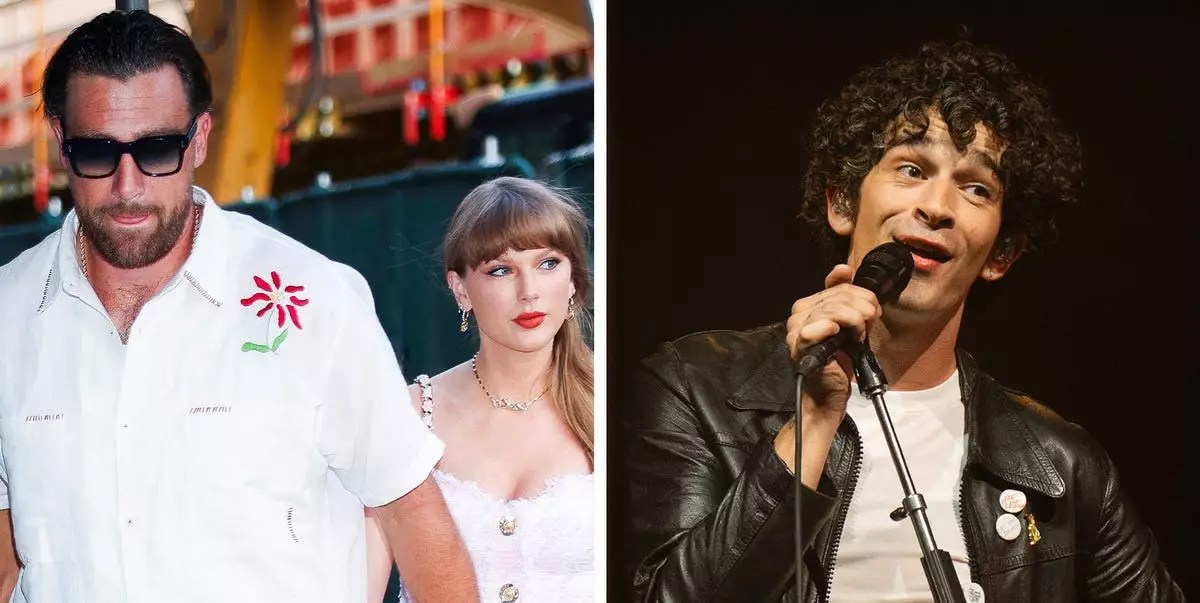In recent weeks, the tangled dynamic between Matty Healy of The 1975 and pop superstar Taylor Swift has resurfaced in the public eye, but not through direct dialogue. Instead, Healy’s veiled barbs at Swift during The 1975’s Glastonbury performance and Swift’s measured yet meaningful response through public appearances have dominated headlines. The spectacle offers a fascinating glimpse into how nuanced interpersonal tensions between high-profile musicians can unfold publicly—not through outright confrontation, but through art, performance, and carefully curated everyday moments.
During The 1975’s set on the iconic Glastonbury stage, Healy employed sarcasm and self-praise, branding himself as “probably the best songwriter of my generation” and a “generational wordsmith”—terms loaded with irony and pointed intention. His reference to poetry, repeatedly emphasized, felt less like humblebragging and more like a sharp nudge directed at Swift’s album *The Tortured Poets Department*, widely interpreted as containing several tracks inspired by their breakup. This cheeky bravado captured fans’ attention, sparking viral clips and fan reactions who quickly recognized the parallel.
Swift’s Silent Yet Effective Countermove
Taylor Swift’s response was characteristically restrained but no less telling. Instead of directly addressing Healy’s public roast, she took a different route—living her personal life openly with her boyfriend, NFL star Travis Kelce. Paparazzi-captured moments of the couple holding hands and sharing a date night in New York City painted a picture of stability and genuine happiness. The gesture was subtle but potent: a non-verbal retort demonstrating the adage “living well is the best revenge.”
This approach aligns perfectly with Swift’s public persona, which often balances vulnerability and strength. Rather than engage in a war of words, she let her flourishing relationship and poised public appearances make a statement that resonated louder than any direct rebuttal could. Swift’s choice to focus on her personal happiness rather than fueling public drama demonstrates an emotional maturity and strategic wisdom, remembering that personal dignity often outweighs the fleeting satisfaction of a sharp retort.
Lyrics as Emotional Confrontation
What makes this scenario particularly compelling is the continued role of music as the primary battlefield for these emotional undercurrents. Swift’s album *The Tortured Poets Department* is believed to house reflections on her relationship with Healy, transforming personal pain into art that resonates with millions. Healy’s sarcastic invocation of “poetry” during Glastonbury implicitly challenges Swift’s narrative while simultaneously acknowledging its existence and impact.
This interplay pushes the age-old tradition of musicians airing personal grievances through their work into public consciousness in real-time. It’s an intricate dance between vulnerability and provocation, underscoring that their artistry cannot be easily disentangled from their personal lives. What’s poignant here is Swift’s unwillingness to engage Healy directly outside her music and personal happiness, suggesting that she feels her songs already speak adequately for her.
New Beginnings Amidst Old Wounds
Swift’s post-breakup relationship with Kelce is more than just a public rebound; it symbolizes a fresh chapter forged after emotional turbulence. Sources close to Swift have shared that she sees Kelce as “her person,” indicating serious intentions not clouded by haste. Their carefully documented date night, complete with coordinated fashion choices, hints at shared joy and mutual support.
Kelce’s NFL schedule and Swift’s commitment to attending his games reflect a partnership built on genuine interest and tangible presence. After years of relentless touring and chaotic schedules, this coupling represents balance and normalcy—something both artists, especially Swift, have openly craved. This grounding relationship steadily shifts the narrative away from past heartaches and gossip, focusing instead on authentic connection and growth.
The Power of Resilience and Image Control
The Matty Healy-Taylor Swift episode illustrates a profound lesson on resilience in the face of public scrutiny. Healy’s tendency to provoke and assert dominance publicly contrasts sharply with Swift’s calmer, image-conscious navigation of her post-breakup life. Both approaches carry risks and rewards: for Healy, the risk of appearing bitter or petty; for Swift, the challenge of maintaining strength without appearing aloof.
Ultimately, this episode demonstrates that in the age of social media and instant viral moments, the way public figures choose to respond to personal turmoil can either escalate drama or quietly reclaim their narrative. Swift’s ability to reframe the story with grace and effectiveness, without uttering a direct word in return, reveals an understanding of power that isn’t raw noise but strategic silence made visible through action.
In an industry often driven by controversy and spectacle, this ongoing indirect exchange reminds us that maturity, artistry, and personal growth can prevail over fleeting provocations—if you know how and when to wield them wisely.


Leave a Reply